In 2018, Safe Work Australia a full review of the national model codes of practice were undertaken, the changes were limited to usability, readability and technical accuracy of the codes - no substantial content/policy changes were included.
These codes were commenced on 1 March 2021, the codes that were included in the amended code rollout are as follows:
How to manage Work Health and Safety risks Code of Practice 2021
Excavation work Code of Practice 2021
Safe design of structures Code of Practice 2021
First Aid in the workplace Code of Practice 2021
Abrasive blasting Code of Practice 2021
Confined spaces Code of Practice 2021
Hazardous manual tasks Code of Practice 2021
Managing the work environment and facilities Code of Practice 2021
Demolition work Code of Practice 2021
How to safely remove asbestos Code of Practice 2021
Welding processes Code of Practice 2021
Managing noise and preventing hearing loss at work Code of Practice 2021
Managing risks of hazardous chemicals in the workplace Code of Practice 2021
Work Health and Safety consultation, cooperation and coordination Code of Practice 2021
Spray painting and powder coating Code of Practice 2021
Managing electrical risks in the workplace Code of Practice 2021
Managing the risks of plant in the workplace Code of Practice 2021
Labelling of workplace hazardous chemicals Code of Practice 2021
How to manage and control asbestos in the workplace Code of Practice 2021
Managing the risks of falls at workplaces Code of Practice 2021
Preparation of safety data sheets for hazardous chemicals Code of Practice 2021
All businesses must do a review of their current documents, processes and procedures to ensure they comply with the updated codes of practice. This upholds a WHS culture within your organisation and will benefit you in the long run.






